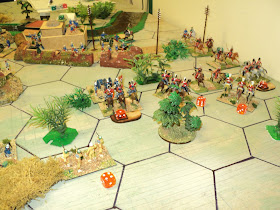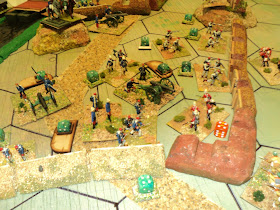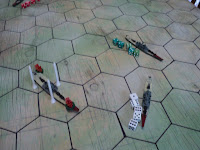 |
| Overlooking 51st Division's position at Qusebah. |
Continuing on from last time, the Rajistan Expeditionary Division (RED) has at last been confronted by a strong and determined enemy, entrenched to the eyes, the fortifications augmented by artillery and mitrailleuse machine guns. The main Sakhdad highway lying on the east bank of the Pardis River, that was the main avenue of advance, astride which, three of the four small Turkowaz infantry Divisions were dug in.
 |
| General Scarlett's battle plan. |
The two successive lines formed an angle, their righ flank resting upon the riverbank, the left flank sharply refused. The mitrailleuses of 45th and 51st Divisions were placed in the angles of the respective earthworks they occupied. Covering the otherwise open flank waited the Sipahi Brigade (14th), Nasr-Ed-Din's best formation. The weak 35th Division stood on the west bank against an unlikely approach from that direction, but also to protect the shore battery overlooking the reach that passed in front of the 38th Division lines. Unless otherwise engaged, the 35th were under instructions to hold themselves in readiness to cross the river by bridge of boats close by Qusabah township.
 |
HMS Shoofly taking hits from the shore battery directly
behind the camera. |
A good deal of the battleground was covered with a light scrub (indicated by the light green patches on the map). This terrain offered neither protection nor concealment but did block line of sight. For that reason it was some assistance to General Scarlett's battle plan, offering as it did a covered approach to the enemy flank. The few dark green patches indicate heavier brush, tall and dense enough, for example, to mask from the shore battery the approach of the gunboat Shoofly before reaching the westward bend in the river close by Bustan village.
 |
The Dorsets returning behind Bustan after initial attack
easily repulsed by mitrailleuse fire |
Once the vessel emerged, however, she came under immediate gunfire from the shore battery, assisted for a short while (one turn) by 38th Division's artillery. Someone must have trained the shore gunners well. Three salvoes were enough to cause considerable damage to the gunboat (loss of 2 of its 5 Strength Points), whereat Lt-Cdr Reding ordered full speed astern. Not yet within range of its own main armament, HMS Shoofly was not prepared to try conclusions against a well protected and well served shore battery. She dropped back to the cover of the thick scrub lining the riverbank. Its own gunnery had had meanwhile little discernible effect.
 |
| 17th Brigade attacks. |
Well before the brief riverine action and Shoofly's rather ignominious part in it, the infantry attacks had been going in. General Scarlett's battle plan had following his usual modus operandi: sending in a weak force (Column C) in a frontal demonstration, the main body (Column A) to assault one wing, with two further columns fetching a near (Column B) and a farther (Column D) flanking sweep. The effect would be to place heavy pressure against the Turkowaz 'landward' flank.
 |
| Cavalry action on the north flank. |
The Columns comprised the following (see army list
previous posting):
Column A: 17th Brigade and 5th Hants Field Artillery;
Column B: 18th Brigade and 'X' Mountain Artillery Brigade;
Column C: 16th Brigade and 1st Rajistan Mountain Artillery;
Column D: 6th Cavalry Brigade.
Except 'C', each column carried a detachment of Gatling guns.
 |
| 17th Bde Gatlings in action. |
The early attacks were rather slow to get rolling, and took on to begin with a rather piecemeal appearance (low activation rolls, which, after all the artillery fire - counting the gunboat - left little room for other action. Passing through Bustan village, 2nd Dorset Infantry at once felt the whiplash of mitrailleuse volley-fire. The regiment fell back through the village with rather more alacrity than it had advanced. However, under cover of the Dorsets' attack and concentrated artillery fire upon the 'angle' position, 1st Oxfordshire and Buckinghamshire Light Infantry (the Ox and Bucks) closed in unscathed upon the entrenchment and swept over the mitrailleuses.
 |
| 1st Ox and Bucks overrun the 41st Division mitrailleuse position. |
Surging through the line, they reached the 45th Division gun line, but, surrounded on three sides by enemies, were unable to make further progress. They were helped somewhat by 22nd Punchinjab infantry attacking and damaging the Turkowaz 177th Regiment. But nothing could prevent the 152nd Regiment of 38th Division assailing the Ox and Bucks' left whilst three Turkowaz artillery batteries pounded them from in front.
 |
22nd Punchinjab Infantry, assaulting the 177th Regiment line,
still haven't breached the earthworks. |
 |
| 152nd Regiment counter-attacking |
Help was coming from 16th Brigade, however. Although the Dorsets were inclined to await a less inopportune moment to advance, the 114th Duke of Wellesley's Rifles were hurrying up behind the Ox and Bucks, ready to throw their weight wherever it might prove effective. We'll leave this part of the narrative for the moment, with the repulse of 22nd Punchinjab Infantry, and the isolated Ox and Bucks barely clinging to the section they have captured of the Turkowaz trench lines.
 |
Ruberian lodgement within Turkowaz defences but
struggling to hold on. |
As the attacks against 45th Division were gradually developing, a rather more brisk series of engagements began between the 6th 'Poona' Cavalry Brigade and the 14th Sipahis. The to and from action was to last all day, rampaging from the edge of the light scrub to the Sakhdad highway and back again, with heavy losses on both sides. Historians have been inclined to award the palm to the Turkowaz Horse, but the fact was that both sides were by the end of the day worn down to remnants. Still and all, the Rajistan cavalry were lucky to have survived at all.
 |
| Elements of 35th Division marching to the guns. |
In the meantime, the urgent summons from Nasr-ed-Din has already reached 35th Division command. Leaving behind 137th Regiment to guard the shore battery, Duya-ed-Din Pasha set 138th and 139th on the march to Qusabah. It would be some hours (turns) before they could be expected to arrive.
 |
| General view |
 |
| Rajistan forces gathering themselves for another blow. |
Between the preceding and the following pictures, the overall situation can be seen to have changed slightly. The Ox and Bucks still cling, under heavy counter-attack to the section of earthworks they have seized. The supporting Sepoy Infantry might have swung to their left to take in the counter-attacking 139th Regiment, but with the repulse of 22nd Punchinjab, were to range up instead upon the right of Qx and Bucks to assail the battered 177th, on the right of 45th Division's line. Had Abdul Jabbar Emir been less pressured he might have withdrawn that unit and inserted the 178th in its place. But it was too late: The 114th DoW Rifles surged over the breastworks alongside their Ruberian comrades. Meanwhile, in the distance, the RED cavalry had surged forward to menace the Turkowaz line of communication, the Sakhdad highway.

The RED cavalry got rather the better of the early clashes. Although the already under-strength Lancers took further losses, the sipahis were thrown back to the very highway itself. The RED cavalry looked set to drive on and sever the Turkowaz army's link to the vital provincial capital.
 |
| Ruberian cavalry threatening the Sakhdad hishway. |
 |
| The Lancers' death ride. |
Boldly (rashly?) handled, the Lancers achieved that very objective. A crisis loomed for Turkowaz - Turnus at the ships! - but, outnumbered five to one (1 SP remaining against their opponents' 5), and their stronger companion units not quite up, the Lancers were finally overwhelmed. The remainder of 6th Cavalry Brigade never did manage that final extra push. This was probably not helped by the Brigade Commander, Lord Garnet, supervising the placing of his Gatling gun detachment overlooking the 51st Turkowaz Division lines, rather than leading his cavalry charges. We're not yet done with the action in this part of the field!
 |
| The cavalry issue still in doubt, though the Lancers have disappeared. |
By this time, the action on 45th Division's front had become general. Despite the re-emergence, greatly daring, of the Dorset Infantry from Bustan village to their aid, the Ox and Bucks Light were at last edged out of their foothold in the angle of the Turkowaz line. The presence of the Dorsets did, however, rather discourage the 152nd Regiment from reoccupying the line. The 114th still hung on to their section of the line, having routed 177th infantry and hit the 178th in its reserve position. The remaining two regiments of 45th Division, 179th and 180th were now under assault from the whole of 17th and 18th Brigades, supported by every artillery piece and Gatling gun that could be brought to bear.
 |
| General action all along the Rajistan front. |
To ease the pressure upon the 45th, elements of the 51st were ordered to counter-attack. It was timely. The 180th Regiment, under attack by three Rajistan battalions, and its left flank enveloped, could scarcely survive for long, especially under the concentric fire of two artillery batteries and, potentially, two Gatling batteries as well. The mitrailleuses of 51st Division were proving insufficient support.
 |
Gatlings in support of attack upon 180th Regiment's hill.
120th Rajinbul holding off counterattack by 204th Regiment. |
Leaping over their earthworks came 203rd and 204th Regiments. The 203rd struck 120th Rajinbul Infantry and sent them reeling into the light brush alongside the 6th Cavalry's Gatling position. In following up, the 204th Infantry came involved in an ineffectual scrub skirmish that was to last for the rest of the day (
That both 204th and 120th Rajinbul ended the day with as many SPs as they began it, was not due to any protection from the terrain. There was none. It was just the way the dice fell out).
 |
Another general view of the action. 149th Regiment
(foreground, alongside the river) has leapt out of their entrenchments
to counter-attack - but come under
a storm of rifle, Gatling and artillery fire. |
Turkowaz determination looked set to defeat the RED attacks when the counter-attack from the right flank also threw back the assailants. Emerging from their earthworks, 149th Regiment drove the Dorsets back towards Bustan. As a result, the 152nd felt emboldened enough to reoccupy the lost angle in the trench line. It now seemed all to do again. Parts of 17th and 18th Brigades had also been repulsed, only two rather worn battalions still trying to force the earthworks, and the tiring Wellesley Rifles maintaining a tenuous salient in the middle of the enemy line.
 |
152nd Regiment has recaptured the 'angle' but 17th Bde
retains a lodgement. |
A 'Glass Half Full' man, General Scarlett was inclined to see good reason for confidence, however. When the Gatling gun fire resumed after 120th Rajinbul dropped back, the 180th Regiment found it all too much and disintegrated, abandoning in rout the small hill it was defending. It then became something of a race who would re-occupy the unoccupied eminence (As I recall, it would depend who won the initiative roll the next turn).


At the same time, the cavalry action continued to swirl about in lively fashion along the Sakhdad highway. Thirty-third QVOLH even drove 40th Sipahi all the way back to the Pardis riverbank. Unfortunately, the 41st Sipahi served out 16th Dragoons in like fashion, and the Light Horse themselves had become badly depleted. As elements of 51st Division seemed at last to be taking an interest in the cavalry fight, the Rajistan cavalry, such as remained, fell back towards the scrub country to the east. There would be no further attempt to sever the Sakhdad highway. It soon transpired, however, that the Turkowaz horse were not prepared to let matters rest there.
 |
| 33rd Cavalry losing its battle with 42nd Sipahi. |
The dragoons, it turned out, were required by the Brigade Commander, to lend a hand to 120th Rajinbul to drive off Turkowaz infantry that was closely engaging them. Although the scrub was not very good going for cavalry, it was reasonable to suppose that their added weight should fling the enemy infantry back into their works. It was not to be. Even under combined attack, the isolated Turkowaz battalion (rated 'poor', mark you) kept their enemies at bay without difficulty. Meanwhile, the flank guard presented by 33rd Cavalry did not last long. Forty-first Sipahi scattered them with a final charge (The dice tell the story: the light horse rolled '4', no result; the Sipahi rolled a '6' - a hit. The light horse roll for effect - a '1'. Having lost its last SP, the light horse disappeared over the skyline).
 |
| 41st Sipahi continue the charge into the rear of 16th Dragoons. |
Then the Sipahi followed up, straight into the rear of the dragoons struggling to drive back the Turkowaz infantry in the scrub. Scoring another hit (5 on the green die, below), the sipahis prevented the dragoons' breaking off. Shortly afterwards, the latter forced their escape from the trap by turning to face the sipahis and driving them back (Lucky die-roll!). At about this time, the Turkowaz army had fairly well fought itself to a standstill. Accordingly, the sipahis fell back to to Sakhdad highway.
 |
| The Dragoons struggle to break clear... |
The line of 45th Division had in the interim been forced altogether from their earthworks, and the remaining regiments, badly depleted, were being chivvied back towards the 51st Division lines. The help from 38th Division had soon melted away. Caught in front of the trench lines, 149th Regiment came in for a terrible battering from gun fire, including that of the emboldened HMS Shoofly, and quickly fell back - what there was left of it - to their original position. Having reoccupied the position in which the 45th Division mitrailleuses had stood, 152nd Regiment also came in for heavy concentric attacks and Gatling gun fire. Heroically, the Regiment died where it stood.
 |
| 41st Division's line finally gives way completely. |
It wasn't long before all that remained of the Turkowaz army east of the 51st Division trench lines was 204th Regiment, still engaged in its popping musketry duel in the scrub against 120th Rajinbul Infantry.
The Turkowaz counterattacks at an end, General Scarlett exhorted his own flagging army to one more effort. The result might easily have been foreseen. There was still enough fight in the Turkowaz to resent being hustled. With further losses, the Rajistan Expeditionary Division had had enough. The battle petered out with the fading of daylight.
Both sides had reached their exhaustion point, the Turkowaz just one turn before the Rajistan. Driven out of their first line, the former consolidated about their second. If anything, that second line would have proved an even stronger obstacle that the first.
 |
General view at the end of the action. Three
quarters of the front trench line has been cleared
of its Turkowaz defenders. |
There could be no doubt about it, though: their stout defence had cost 41st Division their very existence. Only remnants remained of 178th and 179th Regiments at day's end; what was left of 177th and 180th Regiments were fugitives, by nightfall well on the way northward along the Sakhdad highway. Nor did 38th Division come off lightly. 152nd Regiment's gallant counter-attack and final stand was to become legendary in Turkowaz military annals, whilst 149th had also taken heavy losses.
Finally, the Turkowaz were inclined to claim victory in the cavalry battle (not to say in the battle as a whole). True is was that they had fought their mounted opponents to a standstill, and came within an ace of surrounding and capturing their last Ruberian unit still in action. In fighting their way out, the Dragoons did much to redress the balance. But it could not be said that they achieved their objective, however well within reach it had appeared at one point early in the day.

The outcome has to be seen as a Turkowaz strategic victory. No longer could the RED Army sustain two such costly actions with the enemy still a powerful force in being, and not afraid of a fight, and still with untapped local military resources. Major-General Scarlett was destined, for some time to come, to remain a major-general. Not for him the accolades of taking the fabulous ancient city of Sakhdad. Not for him the glorious end to a hard campaign. Not for him the heady heights of Corps command and, perhaps, hope for a peerage.
The following day, he disconsolately ordered the march back to Hak-al-Amara.
Possibly to be continued...

























































